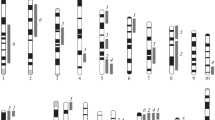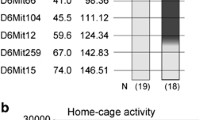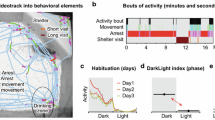Abstract
Quantitative trait loci (QTL) analysis was used to make provisional identification of loci containing genes influencing vulnerability to stress. The effect of restraint stress on openfield activity was measured in C57BL/6J and DBA/2J inbred strains of mice and in 22 B×D recombinant inbred strains of mice. QTL analyses were performed by correlating the behavioral delta scores for each group with the strain distribution pattern of 1300 markers for the B×D mice. A significant association was found between postrestraint rearings during min 5 through 8 in the open field and theLamb2 marker on chromosome 1 (r=.718,p<.0001). Significant associations at thep<.0001 level were also found between baseline open-field rearings of control mice during min 0 through 5 and theZp3, Ache, andMr66-1 markers on chromosome 5, baseline open-field rearings of control mice during min 5 through 8 and thePmv42 marker on chromosome 15, and open-field rearings of experimental mice during min 0 through 5 and theD11Ncvs61 marker on chromosome 11.
Similar content being viewed by others
References
Belknap, J. (1992). Empirical estimates of Bonferroni corrections for use in chromosome mapping studies with the B×D recombinant inbred strains.Behav. Genet. 22(6):677–684.
Belknap, J., and Crabbe, J. (1992). Chromosome mapping of gene loci affecting morphine and amphetamine responses in B×D recombinant inbred mice. In Kalivas, P., and Samson, H. (eds.), The Neurobiology of Alcohol and Drug Addiction.Ann. N.Y. Acad. Sci. 654:311–323.
Belknap, J., Crabbe, J., Plomin, R., McClearn, G., Sampson, K., O'Toole, L., and Gora-Maslak, G. (1992). Single-locus control of saccharin intake in B×D/Ty recombinant inbred (RI) mice: Some methodological implications for RI strain analysis.Behav. Genet. 22(1):81–100.
Belknap, J., Metten, P., Helms, M., O'Toole, L., Angeli-Gade, S., Crabbe, J., and Phillips, T. (1993). Quantitative trait loci (QTL) applications to substances of abuse: Physical dependence studies with nitrous oxide and ethanol in B×D mice.Behav. Genet. 23(2):213–222.
Brown, B., Bifulco, A., and Harris, T. (1987). Life event vulnerability and onset of depression: Some refinements.Br. J. Psychiat. 150:30–42.
Copeland, N., Jenkins, N., Gilbert, D., Eppig, J., Maltais, L., Miller, J., Dietrich, W., Weaver, A., Lincoln, S., Steen, R., Stein, L., Nadeau, J., and Lander, E. (1993). A genetic linkage map of the mouse: Current applications and future prospects.Science 262:57–66.
Curzon, G. (1989). 5-Hydroxytryptamine and corticosterone in an animal model of depression.Prog. Neuropsychopharmacol. Biol. Psychiat. 13:305–310.
Gershon, E., Berrettini, W., Nurnberger, J., Jr., and Goldin, L. (1989). Genetic studies of affective illness. In Mann, J. (ed.),Models of Depressive Disorders, Plenum, New York, pp. 109–142.
Gora-Maslak, G., McClearn, G., Crabbe, J., Phillips, T., Belknap, J., and Plomin, R. (1991). Use of recombinant inbred strains to identify quantitative trait loci in psychopharmacology.Psychopharmacology 104:413–424.
Harvald, B., and Hauge, M. (1965). Heredity factors elucidated by twin studies. In Neel, J., Shaw, M., and Schull, W. (eds.),Genetics and the Epidemiology of Chronic Diseases, Public Health Service Publication 1163. U.S., Department of Health Education and Welfare, Washington, DC.
Kennett, G., Dickinson, S., and Curzon, G. (1985). Central serotonergic responses and behavioral adaptation to repeated immobilisation: The effect of the corticosterone synthesis inhibitor metyrapone.Eur. J. Pharmacol. 119:143–152.
Mendlewicz, J., and Rainer, J. (1977). Adoption study supporting genetic transmission in manic-depressive illness.Nature 268:327–329.
Neiderhiser, J., Plomin, R., and McClearn, G. (1992). The use of C×B recombinant inbred mice to detect quantitative trait loci in behavior.Physiol. Behav. 52:429–439.
Neumann, P. (1990). Two-locus linkage analysis using recombinant inbred strains and Bayes' theorem.Genetics 126:277–284.
Neumann, P. (1992). Inference in linkage analysis of multifactorial traits using recombinant inbred strains of mice.Behav. Genet. 22:665–676.
Plomin, R., and McClearn, G. (1993). Quantitative trait loci (QTL) analyses and alcohol-related behaviors.Behav. Genet. 23(2):197–211.
Plomin, R., McClearn, G., Gora-Maslak, G., and Neiderhiser, J. (1991). Use of recombinant inbred strains to detect quantitative trait loci associated with behavior.Behav. Genet. 21(2):99–116.
Seale, T., Carney, J., Johnson, P., and Rennert, O. (1985). Inheritance of amphetamine-induced thermoregulatory responses in inbred mice.Pharmacol. Biochem. Behav. 23:373–377.
Silver, J., and Buckler, C. (1986). Statistical considerations for linkage analysis using recombinant inbred strains and backcrosses.Proc. Natl. Acad. Sci. USA 83:1423–1427.
Taylor, B. (1978). Recombinant inbred strains: use in gene mapping. In Morse, H. (ed.),Origins of Inbred Mice, Academic Press, New York, pp. 423–438.
Trudeau, L., Aragon, C., and Amitz, Z. (1990). Effects of ethanol on locomotor depression and corticosterone release induced by restraint-stress: Support for stress-ethanol interaction.Pharmacol. Biochem. Behav. 36:273–278.
Wender, P., Kety, S., Rosenthal, D., and Schulsinger, F. (1986). Psychiatric disorders in the biological and adoptive families of adopted individuals with affective disorders.Arch. Gen. Psychiat. 43:923–929.
Willner, P. (1990). Animal models of depression: An overview.Pharmacol. Ther. 45:425–455.
Author information
Authors and Affiliations
Rights and permissions
About this article
Cite this article
Tarricone, B.J., Hingtgen, J.N., Belknap, J.K. et al. Quantitative trait loci associated with the behavioral response of B×D recombinant inbred mice to restraint stress: A preliminary communication. Behav Genet 25, 489–495 (1995). https://doi.org/10.1007/BF02253378
Received:
Accepted:
Issue Date:
DOI: https://doi.org/10.1007/BF02253378




